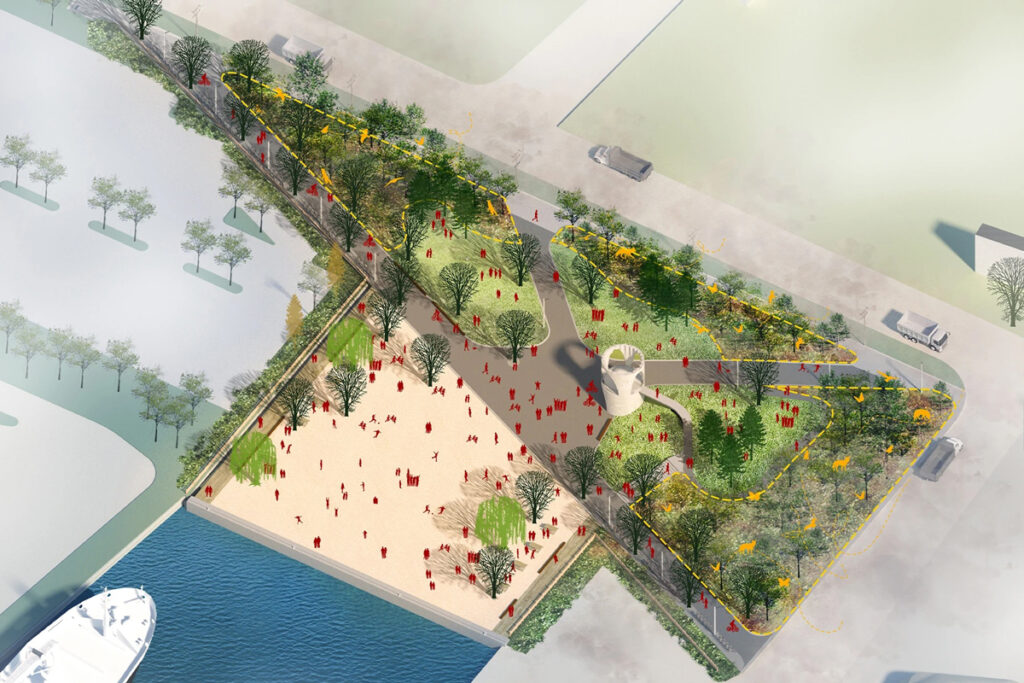
Listen to the full story here:
The Leslie Lookout is a new 1.9-acre park designed and built by the City of Toronto that architects say will create more green space in the city while promoting environmental sustainability.
The new park is located near Woodbine Beach and surrounded by industrial landscape and according to Ontario Construction News, features an artificial beach and “porous asphalt for runoff filtration.”
Multiple companies across Canada partnered up on the project including Québec-based firm CCxA. According to the firm’s website, this opportunity came about after they won a design competition initiated by CreateTO.
“Working on this project was very different from what we are used to working on,” said Marc Hallé, the co-president of the company. “The Leslie Spit was way more of a Wild West type of space, with the Port Lands and industrial areas around it, so it was definitely an interesting experience.”
Heather Schibli, whose company Dougan and Associates worked closely on the project, says her goal with this park was to improve the environment through her love of the arts. This was done by populating the park with trees and other shrubberies.
“I think how you communicate an idea and whether or not it will capture the imagination of those who are learning about it is a big part of [this job],” she said. “I have a very deep appreciation for the creative process, both within humans and with all diversity around us.”
The key element of the park is a mini forest with more than 5,000 plants and representing 45 tree species, which according to Schibli was developed with environmental sustainability in mind.
As explained by Canadian Geographic, this forest was carefully planned using a provincial climate model and brought to fruition by placing flowers, trees and shrubbery strategically to promote the preservation of the park through time.
“We worked very closely with an Indigenous-owned nursery, and we included them from the start of the process, which is not usually the norm,” Schibli said. “And that leads to seeing species that you would not normally see in the city, which is amazing.”
The forest follows the Miyawaki planting style. According to Schibli, this method allows for trees to be planted very close together to mimic the way they would naturally grow.
“It is really important for us to not just address carbon sequestration, but bolster diversity,” highlighted Schibli. “We’re all winners of evolution, and humans really need to stop thinking they’re so amazing, because we are really just one expression of life.”
The Leslie Lookout might have only just opened, but is already attracting a number of Torontonians looking for an afternoon away from the bustle of the city.
“I think it’s amazing that this park was created with local wildlife in mind,” Olivia Pedrech, who was born and raised in Toronto, said. “It’s impossible to undo all the damage done to the ecosystem in Toronto, but I’m glad to see that the city is trying to create spaces to bring some of that diversity back.”
James Li is a civil engineering professor at Toronto Metropolitan University (TMU.) According to him, it is important that the city learns from the past to improve the future.
“It is hard to say whether this is going to make a difference at all,” he says. “We have done a lot to harm the environment, and I don’t know if it can be reversed or minimized on a small scale.”
But Li still considers himself hopeful that Toronto will have a positive impact on the environment.
“I hope the city continues making small steps and setting examples to improve the environment, because it can add up to a lot at the end of the day,” he says.
With multiple companies having worked on this project, Hallé says he has high hopes for the park when it comes to its visitors, and wants it to become a landmark in Toronto.
“At the end of the day, what we want for the park is for it to be a buffer in these sort of dumping areas around Toronto. It would be great to see big events held there like Piknic Électronik in Montréal, or even traditional events for First Nations.”
Claire Dufourd (she/her) is in her fourth year of the journalism program at Toronto Metropolitan University and is part of the On the Record Fall 2024 masthead.
This article may have been created with the use of AI tools such as Google Docs, Grammarly, and/or Otter.ai for transcription.
